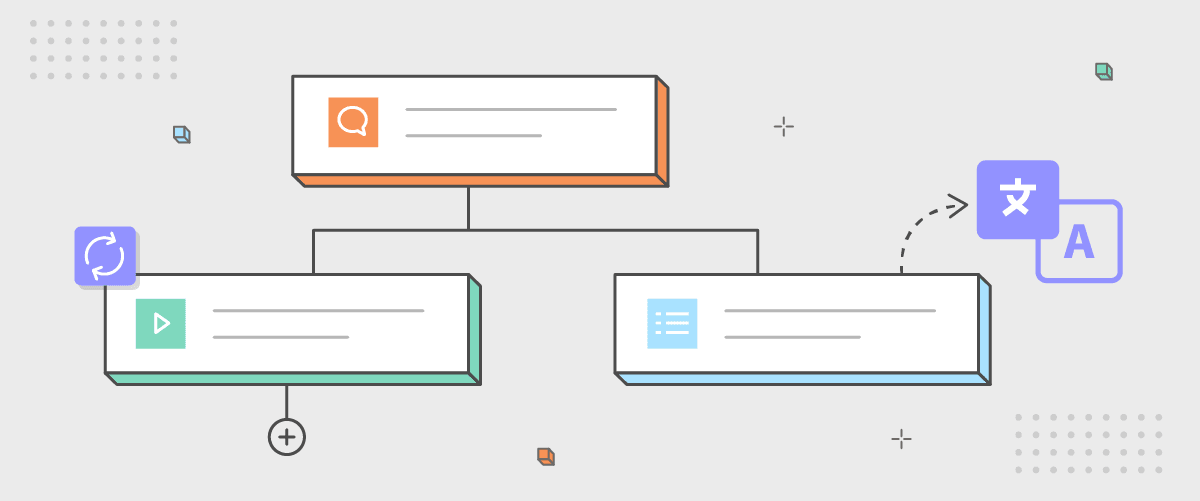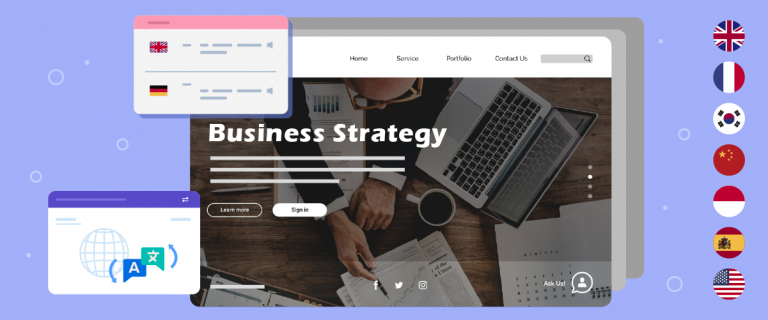An effective translation workflow management is important for every owner of a multilingual website. For companies translating a lot of content, an efficient workflow is needed to produce quality translations. Most companies still use traditional translation workflows. Although proven, this approach has limitations in terms of efficiency.
This article will discuss the steps in the traditional translation workflow, the challenges faced, and ways to build and automate it to enhance translation efficiency for your business needs.
What is translation workflow?
Translation workflow is a series of steps that cover how content is translated, from start to finish. These steps begin with the preparation and review of the content to be translated, the translation work itself, to the delivery of the completed translation.
Translation workflows can involve as few as two steps (translation and publication) or even more. It depends on how comprehensive your translation efforts are and how many people are involved in the process.
The time required to complete a translation can also vary. Overall, more complex translation workflows tend to result in higher-quality translations. However, there are methods to improve translation quality while spending less time and effort on the translation work.
But for now, let’s discuss the traditional translation workflow that is still widely used in businesses today.
Step by step in traditional translation workflow
After understanding what a translation workflow is, you also need to know how the traditional translation workflow proceeds step by step. The steps are divided as follows.
- Document preparation: Determine the scope of translation (blog posts, landing pages, contact forms, website). Then select the target language and establish a writing style guide to maintain the brand’s tone of voice. After that, create a list of specific terms along with their translations. At this stage, it’s essential to clearly define the content that needs to be translated and the languages it should be translated into. A style guide and glossary help ensure consistency and accuracy throughout the translation process.
- Document review: Once the documents are prepared, they will be sent to the translator for review regarding the complexity of the content. The translator will assess whether the content falls within their area of expertise. They will also verify that all necessary materials, such as the style guide and glossary, have been provided. This step helps ensure that the translator is equipped to handle the project effectively.
- Document translation: The next step is for the translator to translate the content from the source to the target language. Translation services may also perform back translation for accuracy verification. During the translation process, the translator may reach out to you for clarification or additional context if needed. Back translation, where a second translator translates the translated material back to the source language, can help identify any potential inaccuracies or misinterpretations.
- Editing proofreading: Next, the text will be reviewed to ensure accuracy, consistency of terms, style conformity, and proofreading to correct writing errors, grammar, punctuation, and formatting. The editing process involves a thorough review of the translated text to ensure it accurately conveys the meaning of the original content, adheres to the provided style guide, and has been effectively localized for the target audience. Proofreading catches any remaining surface-level errors in spelling, grammar, and formatting.
- Formatting: Translation services will format the translated text according to specifications, such as adjusting the writing format from left to right or vice versa. Proper formatting is crucial for ensuring the translated content is presented in a way that is easily readable and culturally appropriate for the target audience. This step may involve adjusting text direction, applying specific fonts or layouts, or adapting the content to different file formats.
- Publication of translated content: The content is ready for use once approved. Avoid modifying the text to prevent changes in meaning. It’s important to maintain the integrity of the translated content by not making any further edits or modifications, as this could potentially alter the intended meaning or introduce inaccuracies. The translated content should be published or used as-is, unless additional revisions or updates are required, in which case the translation process may need to be repeated.
Issue traditional translation workflow
The traditional translation workflow is quite lengthy, but it can provide quality translation results considering it’s carried out by professional translators.
However, being conducted through human translation, traditional translation brings about several issues. Here are some of the problems in the traditional translation workflow.
The traditional translation workflow can be lengthy, yet it can yield quality translations, given that it’s carried out by professional translators.
However, because it’s done through human translation, traditional translation poses several challenges. Here are some of the issues with traditional translation workflow.
Time-consuming
The traditional translation workflow involves several steps, each of which takes time. Moreover, the back-and-forth communication between the translation service provider and the company often prolongs project schedules. If errors occur, necessary corrections can also delay the delivery of translated content. Overall, this workflow can be very time-consuming, especially for large translation projects.
Costly
Hiring professional translation services can be quite expensive. Costs vary based on factors such as experience level, but you can expect to pay between $0.08 to $0.25 per word to hire a professional translator. Costs will also increase if you need to translate content into multiple different languages.
Not scalable
Because you’re employing professional translators to translate content manually, you’ll need to recruit more translators to scale up your translation content production efforts. Increasing translation capacity in this manner can be challenging if you have limited time and budget.
Difficult to track with multiple projects
From a workflow management perspective, managing various translation projects simultaneously can be burdensome. When you have many document or content translation projects to handle, it can be challenging to focus on each project individually. As a result, monitoring the progress of each translation project becomes challenging.
How to build an effective translation workflow
Now that you know the challenges faced when using traditional translation workflows, let’s see how to build an effective translation workflow for your business. Here are some things you can do.
Automate processes
To build an effective translation workflow, it’s crucial to automate as many processes as possible. This can be achieved by using translation tools or platforms that simplify and automate various tasks, reducing the need for manual intervention.
One of the key benefits of automation is the ability to handle large volumes of content efficiently. By leveraging machine translation software, can translate a significant amount of text with high accuracy instantly.
Additionally, automation can streamline the collaboration process. Many translation tools allow you to invite internal team members and external translation agencies to participate in translation projects. This centralized collaboration simplifies the review and editing process, ensuring consistency across translated content.
Leverage machine translation and post-editing
Another tip is to leverage machine translation technology. Using MT, you can quickly generate initial translations for large volumes of content, which can then be post-edited by invited professional translators to your website.
Machine translation post-editing involves reviewing and refining machine-translated text to ensure accuracy, linguistic quality, and adherence to your brand style guidelines. This approach combines the efficiency of machine translation with the expertise of human translators, resulting in high-quality translations while minimizing time and costs.
Integrate with other systems
Integrating with other systems is paramount for a seamless translation workflow. By integrating with existing platforms like content management systems (CMS) or web builders, the translation process becomes more efficient and cohesive. This integration streamlines data flow, enhances collaboration, and ensures consistency across all channels, resulting in a more robust and scalable translation framework.
Optimize SEO for translated content
If you’re translating website content, your translation workflow may include additional steps to make your translations search-engine friendly. Some translation tools can reduce your workload by automatically translating webpage metadata, organizing subdirectories, and adding appropriate hreflang tags.
Optimizing SEO for translated content is crucial to ensure that your translated web pages are easily found and indexed by search engines. This helps improve the visibility and reach of your website in various global markets. By optimizing SEO translation, you can ensure that your translation efforts not only yield high-quality translations but also enhance the chances of your translated content being discovered by the targeted audience.
Continuously improve
Building an effective translation workflow is an ongoing process that requires continuous improvement and optimization. Regularly review your workflow, identify bottlenecks or inefficiencies, and implement necessary adjustments.
Utilize data and analytics to gain insights into your translation process. Additionally, gather feedback from stakeholders, including translators, project managers, and end users, to better understand their needs and challenges.
Simplify your translation workflow with Linguise
Translation workflows require a certain level of high precision to produce quality translations. However, with processes heavily reliant on manual work, traditional translation workflows can be less effective. Therefore, one option is to use automatic translation and post-editing by leveraging machine translation.
If you’re working on a website translation project, consider utilizing the automatic translation capabilities of Linguise to expedite the translation process.
With up to 97% perfect quality translation, Linguise can generate quality translations, coupled with post-editing capabilities using the front-end live editor feature. Not only can website owners edit translations, but you can also invite professional translators to collaborate and improve translations together.
Most importantly, Linguise also supports multilingual SEO optimization. Therefore, you don’t have to worry about whether your site can be found by audiences from foreign countries.
So, what are you waiting for? Build an effective translation workflow management with Linguise. Register a free Linguise account for a 30-day trial with a limit of 600 thousand words and experience the translation results!




